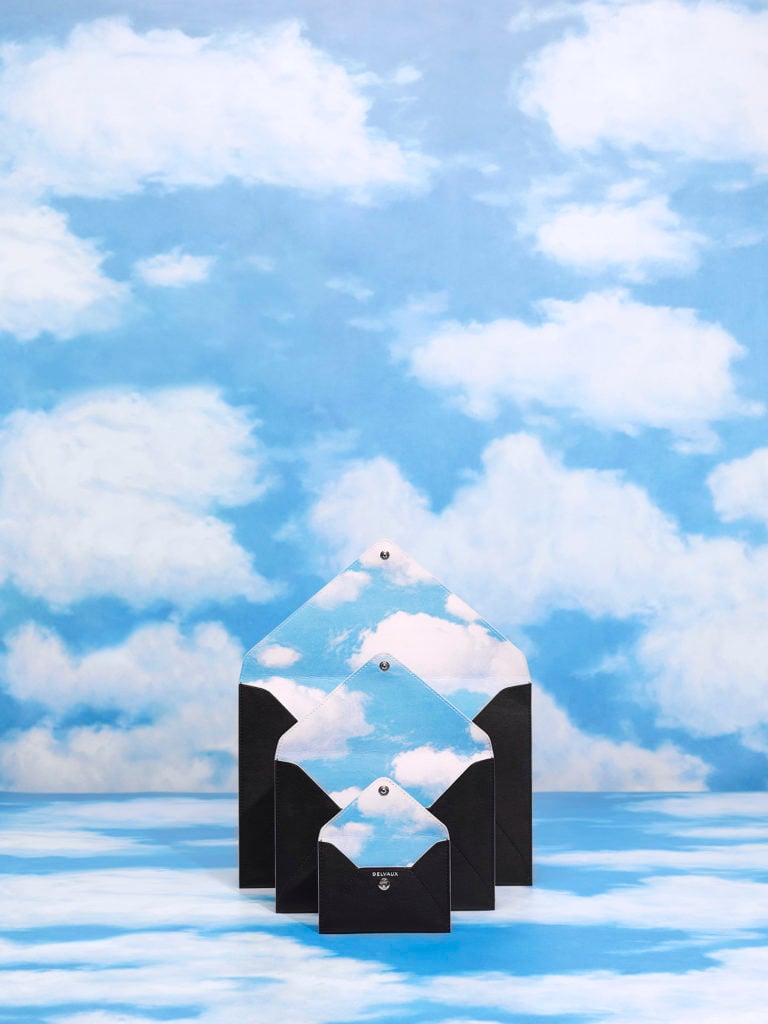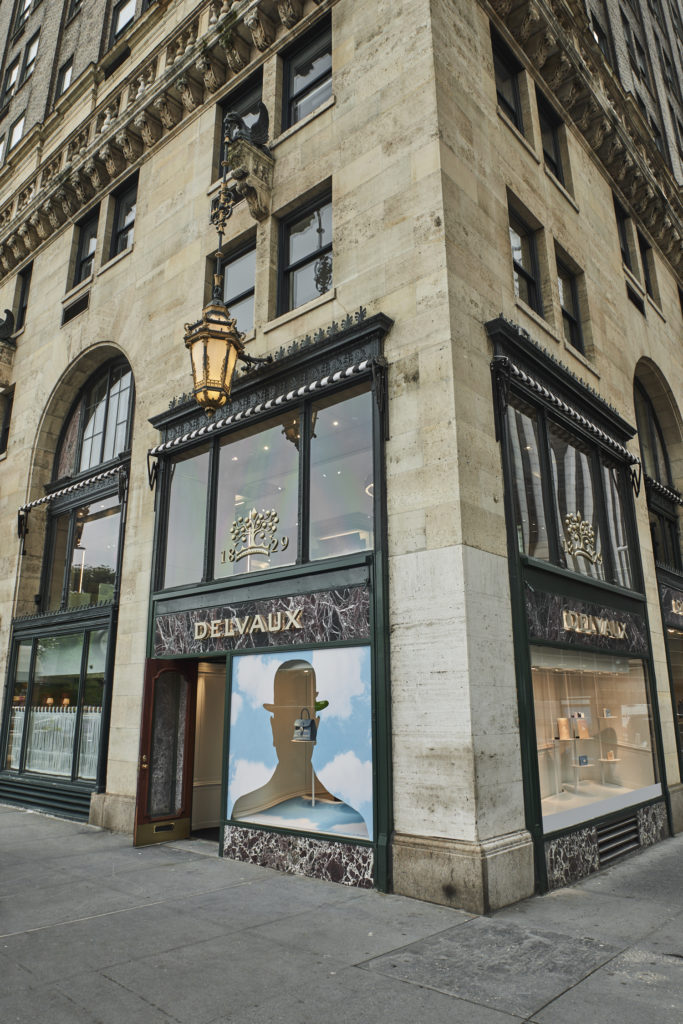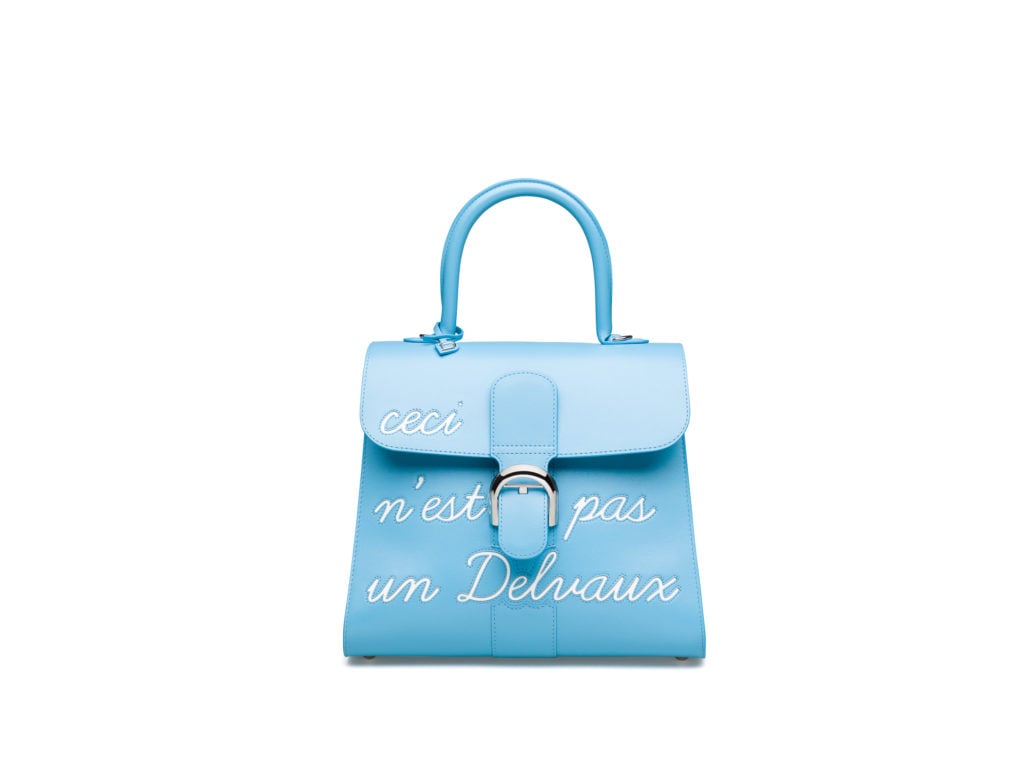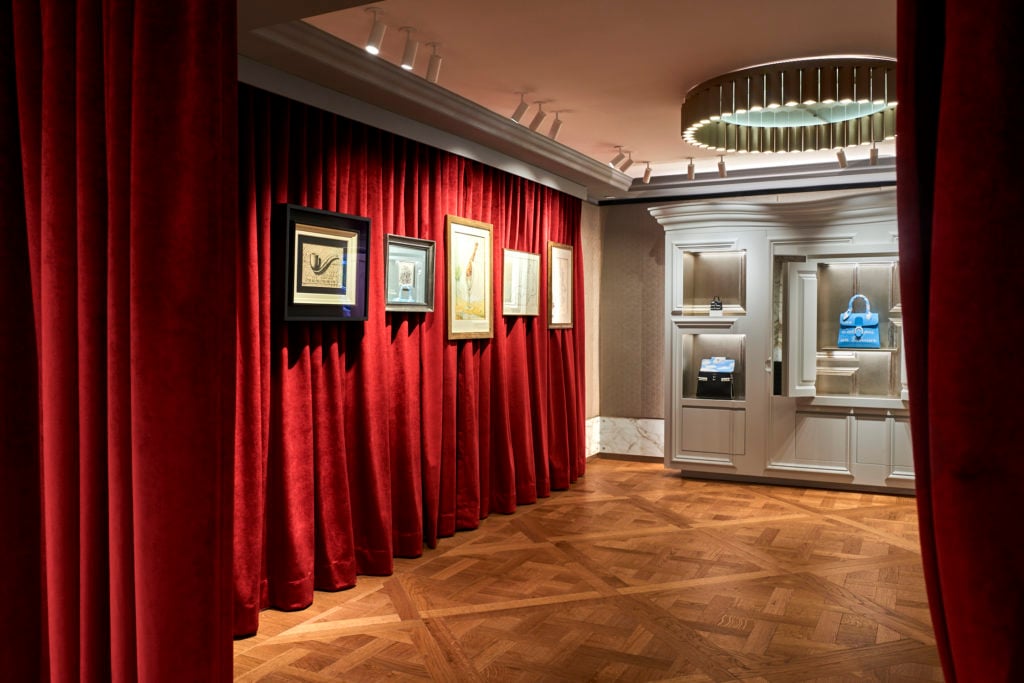Art World
How René Magritte’s Quirky Sensibility Has Inspired Delvaux’s Latest Line of Leather Goods
Five previously unseen works by the Belgian artist are on view to the public at the brand's 5th Avenue location in New York.

Five previously unseen works by the Belgian artist are on view to the public at the brand's 5th Avenue location in New York.

The Belgian leather goods house Delvaux celebrated the launch of a new partnership with the Magritte Foundation this week at its newly inaugurated flagship store, just across from the Plaza Hotel on New York’s famous 5th Avenue.
Officially the fourth partnership between the two brands (following an initial collaboration between Delvaux and the Magritte Foundation and partnerships pegged to retrospectives of René Magritte’s work at the Centre Pompidou in Paris and the San Francisco Museum of Modern Art), the new project aims to bring the Belgian artist’s unique sensibility to Delvaux’s expertly crafted leather goods, from full-size handbags to wallets, luggage bags, and pouches. The whimsical results, which feature, prominently, Magritte’s sense of play, include signature motifs from some of his most well-known works, such as Man in a Bowler Hat (1964), The Promise (1966), Golconda (1953), and others. Also debuting at the store are five previously unseen Magritte works, which will be on view to the public until May 24.
We met with Delvaux’s Chairman and CEO, Jean-Marc Loubier, to talk about the collaboration, Delvaux’s interest in in the Belgian painter, and why the worlds of art and fashion seem to be moving closer together.
Tell us how Delvaux became involved with the Magritte Foundation.
After talking about what everyone would bring to the table, we decided to commit to the foundation long-term and work on developing a relationship with them over many projects. For a successful partnership, you sort of have to think about: how can 1+1 = 3? It’s about the x factor that forms when two different brands come together. You don’t want them to be too similar, because then a collaboration between them becomes boring. From our side, what we’re bringing is history. We’re the oldest leather luxury goods house in the world, and we’ve been manufacturing since we began our company, without pause. We invented something, and did something new: we submitted the first worldwide registration for a handbag in 1908. We’re from Belgium, as Magritte is, and that’s what connects us— it’s a small country, but our culture carries with it a strong emphasis on education, on the arts and on culture. We also put together radical fashion.
When you look at Magritte, he’s very unique; he plays with concepts and objects and the space between those two things. We do the same. We play with concepts and objects ourselves, and through this collaboration we have both credibility, in the art— Magritte is, of course, a very good painter — as well as good craftsmanship, which Delvaux brings, in the quality of our products. So, between these two brands, we’re looking to mix strongly rooted histories, and the backbones of both of our stories, and infuse them with creativity. And creativity, to me, means looking forward.
For our handbags, we went to the Magritte world and with the foundation’s help, picked up a few elements and artfully infused them into the making of the bags. We didn’t want it to be gimmicky. Of course, we’re selling leather goods, but we want our customer to play with these concepts and question the stories behind them, and behind the collaboration. As soon as people start to do that, it means they’re becoming partners with us, in a sense—not consumer, but a client in that creative process.

Delvaux on New York’s 5th Avenue. Image courtesy Delvaux.
Why did you choose to launch the collection in New York?
Because it’s the center of art culture in America, especially at this time of year. There’s Frieze New York, the Whitney Biennial. Being here on 59th Street and 5th Avenue, we’re also in a landmark part of the city. And for that reason—where we’re located—we can present these unseen Magritte works in the form of an exhibition, which would look out of place perhaps on a more commercial street like Madison Avenue. We go beyond the commercial value without being arrogant about it. So it’s a natural way of presenting the art, in an art-centric, iconic part of New York. We’re showing a big piece of Belgium in an important part of New York, that people pass by and come across on their daily adventures. It’s a formal experience—the exhibition takes place in the VIP room on the upper level of our store—but we’re not trying to compete with any of the museums in our presentation, because of course we’re not that. But we’re sharing something of important value nonetheless, and because of that I hope it’s an interesting project.
How did you interpret Magritte’s work for the bags, and what were you trying to convey or achieve with those concepts?
We tried to focus on the elements of his work and the motifs that make up his signature style. So, while we do have bigger bags that feature more literal messages—“Ceci n’est pas un Delvaux”, for example, is written on one of the handbags—on the smaller leather goods, it’s more abstract, and very playful. These elements help us to develop a specific appreciation and aesthetic for the goods, while not being pretentious about the fact that they’re still products at the end of the day. A flagship store can be experiential, for after all, it’s still a store. A bag can feature artwork, but it’s still a bag at the end of the day. So we wanted these pieces to be welcoming: Magritte, as applied through Delvaux, pushes the wearer forward in a way that is comfortable, that inspires curiosity. We have the Magritte blue sky on the inside of several pieces, the Golconda print, also, on another lining. The art work is very integrated into each of the objects, and in that way we wanted it to feel seamless, and approachable for the wearer.

« BRILLANT MM L’HUMOUR, BOX CALF: CIEL » Image courtesy Delvaux.
Art and fashion seem to be moving closer together in many ways. You’re seeing more and more fashion brands collaborate with artists and artist foundations on capsule collections, like this one. Why do you think that is?
We’re at a place where we’re being bombarded with photos constantly, and collaborating across artistic worlds has become a way to attract a wider visual audience. At Delvaux, we aren’t trying to make a point stick, but integrate the two worlds as naturally as possible. I don’t want anything to feel forced. I’m hoping customers are happy and proud to wear these bags, and also understand the reasoning behind the collaboration. I hope the art can help transport them to another cultural moment outside of the current one, and that it makes them smile. That’s something that a collaboration like this one can generate. It’s a special feeling.

Magritte artworks displayed at the upper level of Delvaux’s New York flagship store. Image courtesy Delvaux.
Do you personally have a relationship with art?
I’ve always loved art. I remember in elementary school, which I attended in Avignon, that a teacher of mine was very passionate about Impressionism. Her class brought together people from all different backgrounds, and she’d ask us to help her organize monthly exhibitions based on artists we were learning about. So if we were studying Renoir or Degas, she’d us ask us to find an image—a magazine image, a postcard, or something else—that reminded us of that particular artist. And we would write something about it, and then pull together all the images for a little show, in our classroom. That’s a very old, fond memory of mine and I have loved art ever since.
What does the future look like for Delvaux?
I hope we’re building, every day, our legacy as we expand our presence. The right kind of messaging is very important to me, and that lets us collaborate with artists and show artwork in the right way. I want more stores like this one—a kind of “embassy maison” in different parts of America, that’s emblematic of both the city the stores are in, and our connection to Belgium. The boutiques should carry our history, but respect their locations. So, more stores like this one, and then we’re developing in Europe, too—we just opened in Rome, and we’re going to open a store in Paris on the Rue Saint Honoré. Also, we’re opening more workshops. This year, we opened our third workshop in the east of France. I’m very proud of the fact that we’ve created 500 artisan jobs for our workshops—we pay attention, we pass on craftsmanship training to our employees, and hope it’s a useful skill set to them, whether at Delvaux or elsewhere.

René Magritte, Le bain de cristal, 1946, © Photothèque R. Magritte / Adagp Images, Paris, 2019
As you mentioned, five unseen Magritte works are being debuted at your store. Can you tell us about one or two of your favorites?
My favorite is Le bain de cristal (“The Cut-glass bath”), with the giraffe in a flute of champagne. And then we have a version of Ceci n’est pas une pipe, with a twist!